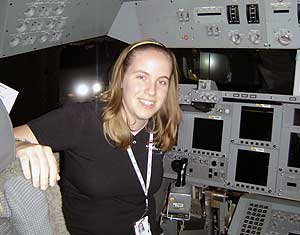Robotics and engineering first caught Fiona Turett’s fancy at NASA Space Academy in Huntsville, Ala., when she was 13. It was the first of many NASA programs in which Turett, who graduates May 15 with a bachelor’s degree in mechanical engineering, has participated.

At her high school in Rochester Hills, Mich., she participated in For Inspiration and Recognition of Science and Technology (FIRST), a national program where teams of students are allowed six weeks to design and build a robot that plays a strategy game. In 2005-06, she captained her 25-member team to a third-place finish in the competition.
Turett’s FIRST experience made her a natural to become a Bandit/Akoya nanosatellite team member in 2006, during her freshman year at WUSTL. Bandit is a nanosatellite not much larger than a cantaloupe designed and programmed by WUSTL students under the supervision of Turett’s adviser, Michael A. Swartwout, Ph.D., assistant professor of mechanical, aerospace and structural engineering.
Bandit functions with its mother ship, Akoya, about the size of a beach ball, which serves as a recharging and communications base for Bandit. The two usually travel no more than 10 feet apart. NASA and the Air Force have great interest in these university-created nanosatellites for their potential to perform a variety of tasks, inspection chief among them.
Over the past three years, Turett produced computer-aided design drawings of the satellites and took active part in the integration and assembly of the vehicles; she gave presentations about the project for design reviews, sponsors and local schools; worked on thermal design and analysis of the spacecraft for her senior design project; and managed the team of 30 working toward completion of the spacecraft for a national Air Force competition. Bandit/Akoya took second place in the contest, held in January.
She also has twice prepared experiments and test beds and flew on NASA’s famed C-9 aircraft, aka “the Vomit Comet.”
“The C-9 is a normal commercial aircraft with most of the seats taken out and padding all over the floor, ceiling and walls,” Turett says. “It’s used for a range of gravity experiments that you can’t do on Earth. To get to zero or reduced gravity, they fly 8,000-foot parabolas, 30 of them. In the 20-25 seconds of microgravity, with the plane in a free-fall to Earth, you do your experiment.
| School of Engineering & Applied Science |
“In the free-fall, you’re actually at normal gravity, but what you’re comparing yourself to is the plane — compared to the plane, you’re floating,” she says. “They give you anti-nausea medications. Most people do fine with the drugs. My body doesn’t like it very much. I get ill.”
Thus, the nasty moniker.
Every summer since 2006, Turett has had a NASA internship — two in Maryland and one last summer at the NASA Johnson Space Center in Houston. She learned a lot of engineering, design and robotics, and contributed to a NASA model of lunar habitat.
“I’ve had lots of really good mentors, both here with Dr. Swartwout and others and at NASA,” she says. “I’m very grateful for that.”
Turett not only is good with numbers (her father, Barry Turett, Ph.D., is a mathematics professor at Oakland University in Michigan), but she also is good with words. She speaks fluent German, conversational French and elementary Spanish.
Advanced Placement courses at her high school, extra work at a local college back home and an early start in elementary education in Europe enabled Turett to graduate at age 20.
“I’ve loved my time here,” she says. “St. Louis is a fun city with so much to do, and it’s a little warmer in the winter than what I’m used to. I’m glad I went to Washington University instead of a strictly engineering school. I’ve met so many people outside of engineering. It gives you a balance.”
She also has been active with WUSTL’s Catholic Student Center, participating in numerous service projects, one involving humanitarian work in Nicaragua, and she plans to spend time this summer in Ecuador.
Turett will start full-time at the Johnson Space Center in July in the Mission and Safety Assurance Office. She will work on the thermal protection subsystem of the Space Shuttle and Orion, a new vehicle being designed for use on the moon.